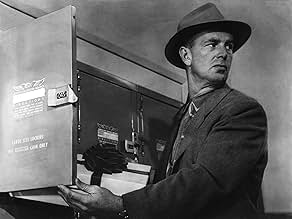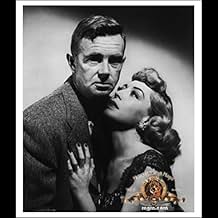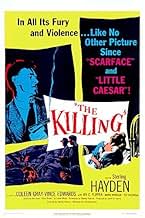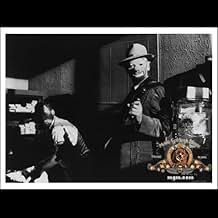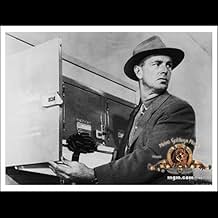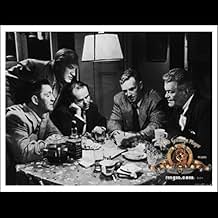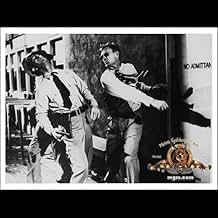El delincuente Johnny Clay reúne a un equipo de cinco hombres para planificar y ejecutar un audaz robo en un hipódromo.El delincuente Johnny Clay reúne a un equipo de cinco hombres para planificar y ejecutar un audaz robo en un hipódromo.El delincuente Johnny Clay reúne a un equipo de cinco hombres para planificar y ejecutar un audaz robo en un hipódromo.
- Dirección
- Guión
- Reparto principal
- Nominado a 1 premio BAFTA
- 1 nominación en total
Ted de Corsia
- Patrolman Randy Kennan
- (as Ted DeCorsia)
Elisha Cook Jr.
- George Peatty
- (as Elisha Cook)
Joe Turkel
- Tiny
- (as Joseph Turkel)
Reseñas destacadas
The Killing is a film whose legacy can still be seen in many films today. This film is not only Stanley Kubrick's first acclaimed film, but it is also credited with inventing the concept of non-linear story telling for the film industry. Some recent films that have used this technique are Reservior Dogs, Pulp Fiction, Go, Wonderland and The Usual Suspects.
The story deals with a motley crew of assorted criminals, inside men, and average joes just looking to get their hands on a large sum of money by stealing it from a racetrack. Sterling Hayden plays Johnny Clay, a hardened criminal who just finished serving a five-year prison sentence. He is the ringleader of the bunch who is determined to only go for the big heists from now on. He figures they can put you away for stealing ten dollars as easily as ten million, so what have you got to lose? The rest of the crew are mostly average people with average problems, as Clay explains early on. Some of them work at the track. One is a crooked cop. Two are hardened criminals added at the last minute to cause diversions. Everything has been timed and planned out to the letter. Of course in a film like this, things never go as planned. It wouldn't be entertaining if they did.
The killing was made on a budget of well below half a million dollars, and it shows. The film looks cheap at times, but the story is more than enough to make you forgive its financial shortcomings. The acting is nothing too special. Hayden is strong and resourceful as Johnny Clay, but he's pretty wooden. Elisha Cook Jr. is pretty good as a hen-pecked husband who is taking part in the scheme to impress his high-maintenance wife. If this film were re-cast today, you'd have to think of William H. Macy to play this character. Timothy Carey is always memorable, even with such a small part like the one he has here. Such a strange-looking guy! He gets the most interesting assignment of all the people in on the heist.
You can really tell this was made fifty years ago. Even though there are hardened criminals and low-lifes in nearly every scene, nobody ever says the F-word! There is, however, a fairly gory shootout in one scene which you normally didn't find in films back then. The killing was ahead of its time in more ways than one, I guess. Please be sure to check this one out! 8 of 10 stars.
The Hound.
The story deals with a motley crew of assorted criminals, inside men, and average joes just looking to get their hands on a large sum of money by stealing it from a racetrack. Sterling Hayden plays Johnny Clay, a hardened criminal who just finished serving a five-year prison sentence. He is the ringleader of the bunch who is determined to only go for the big heists from now on. He figures they can put you away for stealing ten dollars as easily as ten million, so what have you got to lose? The rest of the crew are mostly average people with average problems, as Clay explains early on. Some of them work at the track. One is a crooked cop. Two are hardened criminals added at the last minute to cause diversions. Everything has been timed and planned out to the letter. Of course in a film like this, things never go as planned. It wouldn't be entertaining if they did.
The killing was made on a budget of well below half a million dollars, and it shows. The film looks cheap at times, but the story is more than enough to make you forgive its financial shortcomings. The acting is nothing too special. Hayden is strong and resourceful as Johnny Clay, but he's pretty wooden. Elisha Cook Jr. is pretty good as a hen-pecked husband who is taking part in the scheme to impress his high-maintenance wife. If this film were re-cast today, you'd have to think of William H. Macy to play this character. Timothy Carey is always memorable, even with such a small part like the one he has here. Such a strange-looking guy! He gets the most interesting assignment of all the people in on the heist.
You can really tell this was made fifty years ago. Even though there are hardened criminals and low-lifes in nearly every scene, nobody ever says the F-word! There is, however, a fairly gory shootout in one scene which you normally didn't find in films back then. The killing was ahead of its time in more ways than one, I guess. Please be sure to check this one out! 8 of 10 stars.
The Hound.
Stanley Kubrick's coming-out party from the mid '50s is a startlingly accurate prediction of film's future. By way of a non-linear narration and a few remarkably fresh transitions, Kubrick adds considerable weight and magnitude to a tangled heist tale and its focus on the crooks behind a slick, daring stickup of the local racetrack. Confused by the film's radical new approach to storytelling, test audiences hated the first cut, leading to studio meddling and an almost-complete disintegration of its marketing budget. Kubrick fought back, though, and with the obvious exception of a horribly heavy-handed deadpan narration, the finished product seems virtually untouched. Concerned mostly with the planning and hand-wringing before the big theft, The Killing tensely builds anticipation throughout before finally boiling over in a machine gun-paced robbery scene, terse payoff and all-too-brief elaboration on the major players' ultimate fates. Acceptably acted at best, the real stars of this picture are the complex plot and the harvest of fresh ideas going on behind the lens. A clear inspiration for Tarantino's big hits of the '90s, it's a daring and stylish major market debut for the famed director that hints at the lengths his development would ultimately take the medium.
Stanley Kunbrick was still in his twenties when he made this film, yet his confidence and self-assurance are all over it. It is a well-written story, co-written by Kubrick (based on a novel called "A Clean Break"), about a meticulously planned horetrack heist told from the point of view of the several people who were in on the plot. Most of these guys weren't professional criminals, but otherwise honest men who were down on their luck and needed a break. They turned to this audacious plan in desperation, thinking they could do some real good in their lives with their share of the money. I won't give away the ending of course, but keep in mind this is a Kubrick film. That's all I say about that.
Standouts include Sterling Hayden as the ringleader, Marie Windsor as a snide, manipulative woman, Elisha Cook as her milquetoasty husband, Timothy Carey, as creepy as ever, and Kola Kwariani, the thinking man's Tor Johnson, as a chess expert/hired thug.
Speaking of chess, this is the first movie I've ever seen with a scene taking place in a chess parlor. Being from a provincial New England town, and not being a chess afficionado, I never knew such places existed.
Standouts include Sterling Hayden as the ringleader, Marie Windsor as a snide, manipulative woman, Elisha Cook as her milquetoasty husband, Timothy Carey, as creepy as ever, and Kola Kwariani, the thinking man's Tor Johnson, as a chess expert/hired thug.
Speaking of chess, this is the first movie I've ever seen with a scene taking place in a chess parlor. Being from a provincial New England town, and not being a chess afficionado, I never knew such places existed.
The story of a meticulously-planned race track hold-up is a stunner in every minute you watch it, and the film's progressive use of a partly documentary style has often been acclaimed as uniquely supporting the dramatic goings-on. It definitely put a modern touch to the somewhat out-of-fashion film noir in 1956, but still greatly relied on its basic rules.
A fine new note was the neat distinction between the gang's members' motives, ranging from repaying underworld debts (De Corsia) and hope of offering a better life for his ill wife (Sawyer) to the vain ambition of pleasing his vamp wife by doing something special (Cook).
Despite the film's qualities, Kubrick's treatment of the women's rôles seems more than old-fashioned today. Women here are either the homely and sweet type (Coleen Gray) or the Bette-Davis-eyed and cherchez-la-femme type (Marie Windsor). Both are accordingly taller or smaller than their respective partners by a head.
I should like to mention one of my favourite pans: that's when the bald philosopher-catcher walks up to Joe Sawyer's bar. Lucien Ballard's camera follows him all across the crowded tote hall, a take which must have been very difficult to organize and shoot. Later, the scene is repeated with Sterling Hayden.
This motion picture is also a monument for the great histrionic art of Elisha Cook, Jr., in a stand-out performance as the born loser. (German dubbing gives him the apt voice of Stan Laurel's speaker Walter Bluhm.) This little man never just did his job in unnumerable supporting rôles but has rendered effective homage to the tragic figure on the silver screen more than any other (non-comical) character actor I can think of. Regardless of his versatility in lots of different films, his impersonations of a likeable man who is doomed to fail make him unforgettable: take his lethal parts in "Phantom Lady" (1944), "Shane" (1953) or the likes, the audience's sympathy was always with this fine actor.
A fine new note was the neat distinction between the gang's members' motives, ranging from repaying underworld debts (De Corsia) and hope of offering a better life for his ill wife (Sawyer) to the vain ambition of pleasing his vamp wife by doing something special (Cook).
Despite the film's qualities, Kubrick's treatment of the women's rôles seems more than old-fashioned today. Women here are either the homely and sweet type (Coleen Gray) or the Bette-Davis-eyed and cherchez-la-femme type (Marie Windsor). Both are accordingly taller or smaller than their respective partners by a head.
I should like to mention one of my favourite pans: that's when the bald philosopher-catcher walks up to Joe Sawyer's bar. Lucien Ballard's camera follows him all across the crowded tote hall, a take which must have been very difficult to organize and shoot. Later, the scene is repeated with Sterling Hayden.
This motion picture is also a monument for the great histrionic art of Elisha Cook, Jr., in a stand-out performance as the born loser. (German dubbing gives him the apt voice of Stan Laurel's speaker Walter Bluhm.) This little man never just did his job in unnumerable supporting rôles but has rendered effective homage to the tragic figure on the silver screen more than any other (non-comical) character actor I can think of. Regardless of his versatility in lots of different films, his impersonations of a likeable man who is doomed to fail make him unforgettable: take his lethal parts in "Phantom Lady" (1944), "Shane" (1953) or the likes, the audience's sympathy was always with this fine actor.
There is a plan that just can't fail no matter what, take the racetrack's banked cash roll, take all it's got, everybody knows their place, where to be for the big race, then where to gather, to take their share, of the big pot.
A piece of cinema magic that to this day leaves you astounded at the brilliance of the writer/director, amazed at the sensational performances by some truly great actors, and as engaged as you could ever hope to be with a story that nestles nicely in the age and the era from which it was born, an accomplishment that so many films of that time fail to achieve when revisited.
A piece of cinema magic that to this day leaves you astounded at the brilliance of the writer/director, amazed at the sensational performances by some truly great actors, and as engaged as you could ever hope to be with a story that nestles nicely in the age and the era from which it was born, an accomplishment that so many films of that time fail to achieve when revisited.
¿Sabías que...?
- CuriosidadesInitial test screenings were poor, citing the non-linear structure as the main problem. Stanley Kubrick was forced to go back and edit the film in a linear fashion, making the film even more confusing. In the end, it was released in its original form, and is often cited as being a huge influence on other non-linear films like Reservoir Dogs (1992) and Pulp Fiction (1994).
- PifiasDuring the robbery, it's clear that a significant amount of the money is in neatly banded bundles of crisp brand-new bills, yet when it's transferred from the duffel bag to the suitcase, all the bills are loose, unstacked, and appear well-used.
- Citas
Johnny Clay: You'd be killing a horse - that's not first degree murder, in fact it's not murder at all, in fact I don't know what it is.
- ConexionesEdited into Hai-Kubrick (1999)
Selecciones populares
Inicia sesión para calificar y añadir a tu lista para recibir recomendaciones personalizadas
Detalles
- Fecha de lanzamiento
- País de origen
- Idioma
- Títulos en diferentes países
- Atracament perfecte
- Localizaciones del rodaje
- Empresa productora
- Ver más compañías en los créditos en IMDbPro
Taquilla
- Presupuesto
- 320.000 US$ (estimación)
- Recaudación en todo el mundo
- 380 US$
- Duración
- 1h 24min(84 min)
- Color
Contribuir a esta página
Sugerir un cambio o añadir el contenido que falta


